Olematute kylade project / Project of Non-existent Villages, Võru Linnagalerii/ Võru town gallery, Võru Estonia 28 June -28 July 2014
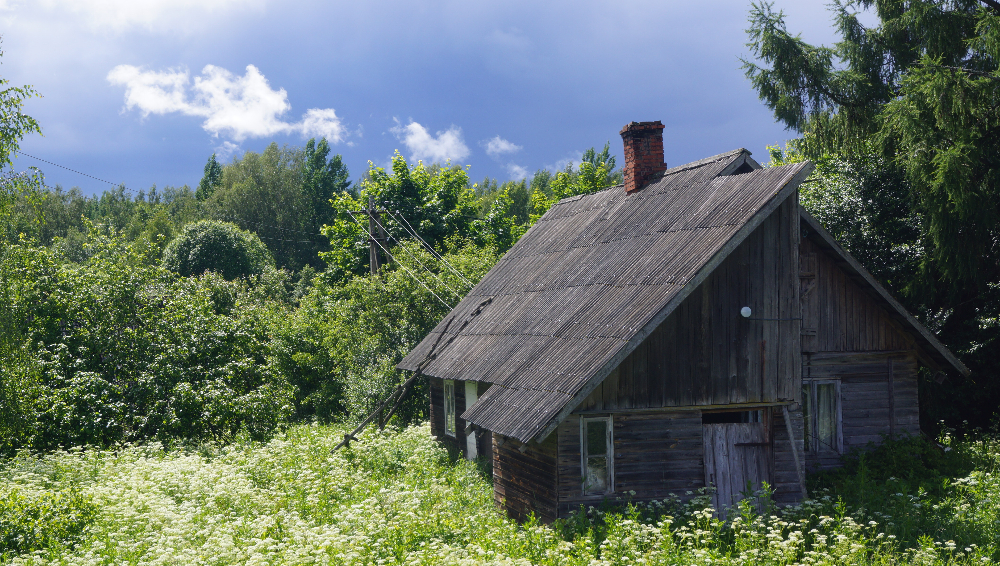
One of the so called non existent villages, Kaluka Village, Võrumaa, Estonia. Photo by Justin Tyler Tate
Taavi Suisalu in his first curatorial endeavor invited Error collective to participate in a group exhibition about abandoned villages in south Estonia. Suisalu applied twice for funding to the Cultural Endowment of Estonia however received support only from Võrumaa Office of Cultural Endowment to rent the bus for the final tour twenty six July. “I also asked sponsorship from gas station chains as there was quite a bit of driving… but no success.” Suisalu who aims to explore the Estonian countryside as the theme of a New Media Art exhibition explained, “In 2013 one hundred and two villages in Estonia were declared abandoned by the government because they have no permanent residents.”((http://uudised.err.ee/v/eesti/558af338-d78d-4cc8-9640-8eb3a460d836))
With no budget Error (for this project Justin Tyler Tate and I) agreed, along with seven other artists, to do the project at our own expense. During Jaanipäev, the week prior to the exhibition we found ourselves in south Estonia, living and preparing art works in a village composed of a house, barn, animal shed and sauna on a twenty acre horse farm transformed into a creative project space since last year called Maajaam.
Erik Alalooga, Taavi Suisalu, Justin Tyler Tate, Kadri Toom, Timo Toots and I went to visit three of the so called abandoned villages, geographically close to Maajaam, but the long and winding roads though relentlessly repetitive landscape is mesmerizing. My thoughts drift back twenty years, finding myself amongst wealthy widowers of the oldest families of the Pacific Northwest of the U.S. for a fund raiser for wetlands hosted by the Portland Woman’s Auxiliary I accompanied two young men, a musician of international notoriety and a dilettante of independent means.
The musician was quite at ease and had the ladies laughing during tea service until the dilettante merged into the conversation, “I recently inherited the manor on the south side of Mount Tabor.”
“I know the house well. Father played polo and I used to ride my horses there when I was a girl.” one frail woman responded, “Will you renovate or rebuild?” she asked.
“Neither,” he replied and after a pause continued, “I will let it decay.” An audible gasp was heard in the room amongst the shocked white haired ladies. Maybe he was right; maybe we should centralize in cities so other species can thrive in suitable habitats.
But as I return to the moment, riding in the car with two improvisational fabricators, Alalooga and Tate, I think, “We could squat one of these villages and have hot sauna by week’s end and functional infra structure within a few months.”
The villages we visited, Kaku, Kaluka and Vorstimägi all had similar layouts to the diorama at the Estonian National Museum in Tartu, house, barn, animal shed and sauna. A cacophony of bird song and bee buzzing, an earthy eco system active under the coverage of tall grass and wild flowers engulf the landscape. Each house, left untended, told stories of subsequent human inhabitants, day drinkers, travelers, surreptitious lovers and the curious.

One of the so called non existent villages, Kaluka Village, Võrumaa, Estonia. Photo by Justin Tyler Tate
Back at Maajaam some of us sleep in the loft of the barn. Midsummer light and wind drift between the wood beams of the roof and walls. Below the loft, on the main level, Volta meters, soldering irons, speakers, circuit boards and wires spread across the table. Suisalu works alongside his open lap top, surfing tutorials to guide him in building a small computer for his installation. Ott Pilipenko arrives with a plastic tool box hacked into a laptop with specialized switch panel for audio visual performance. The windowless barn is illuminated by low tech, led lights in glass jugs suspended from the rafters.
Error does most of the project post production in the house in the company of a smiling dog and a little cat. The interior of the house is renovated DIY with reused materials in the spirit of Estonian minimalism. We investigate the outdated but functional tools and technology neatly displayed. Through the window can be seen grazing horses of Ponimaa.
Error made videos in Kaluka village and appropriated content from Online, remixed it, then published a website and video proposing a fake land development scheme where you can buy shares in a summer cottage called “Village Estates.” The option to perform data mining for multinational corporations in lieu of investment capital is a thinly concealed neo feudal system. At the exhibition, which opened in Voru 28 June, A QR code leading you to the website is drawn on the side of a wooden barrel. Atop the barrel is a wedge of earth with grass and flowers displaced from the site. QR codes are submerged in several small bottles of green, dirty water.
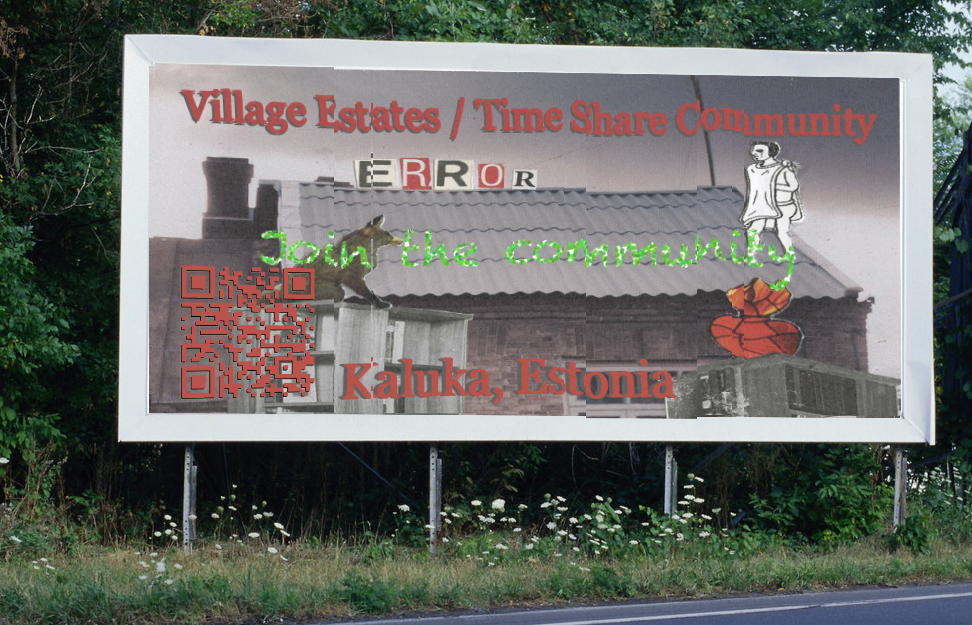
Error Collective, digital image, Village Estates 2014
Next in the gallery is a colorful hand puppet, made from wool and natural materials, the forest creature Kratt3000 represents a game for I-Phone or android devices designed by Pilipenko, using GPS and AR programming to mediate the exploration of disused countryside. Played on your phone, the game suggests simple activities such as lying down to allow the player to feel one in nature.
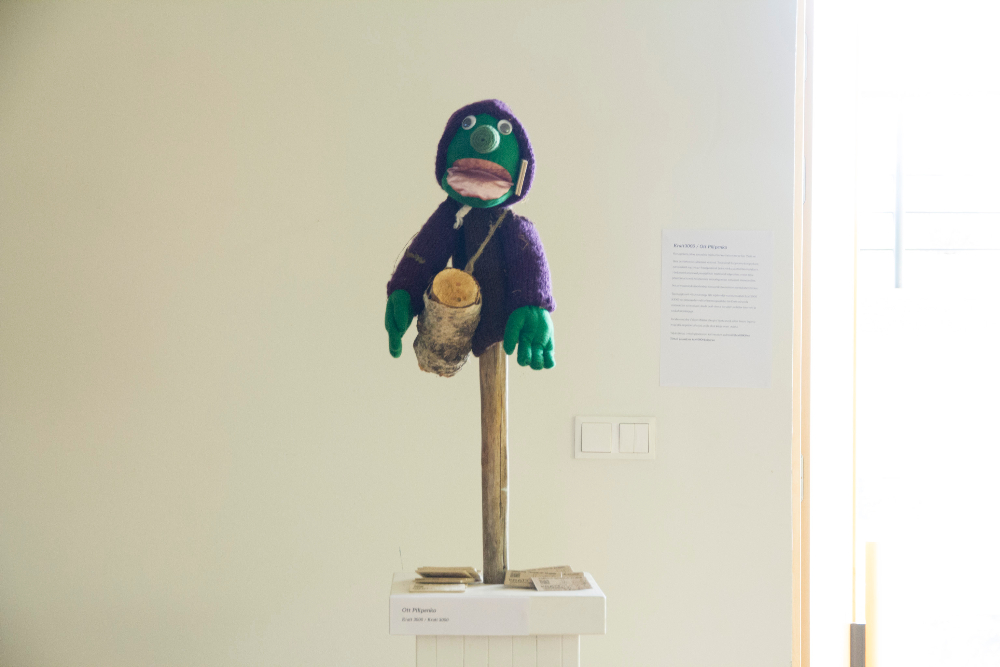
Ott Pilipenko, Kratt3000, mixed media installation, 2014
At the West wall of the gallery stands two and a half meter high construction of rough timber supporting a grid of wooden shingles titled “Laastuekraan” (shingle board) authored by Timo Toots. Evoking the image of a mechanical reader board, the numbers and letters are projected from a Raspberry Pi computer designed and programmed by the artist to continuously collect and display data about 1. busses that go by the sites, 2. the weather and 3. birds in Estonia fitted with GPS tracking devices. New methodologies of collecting make us reassess what data is meaningful and why.
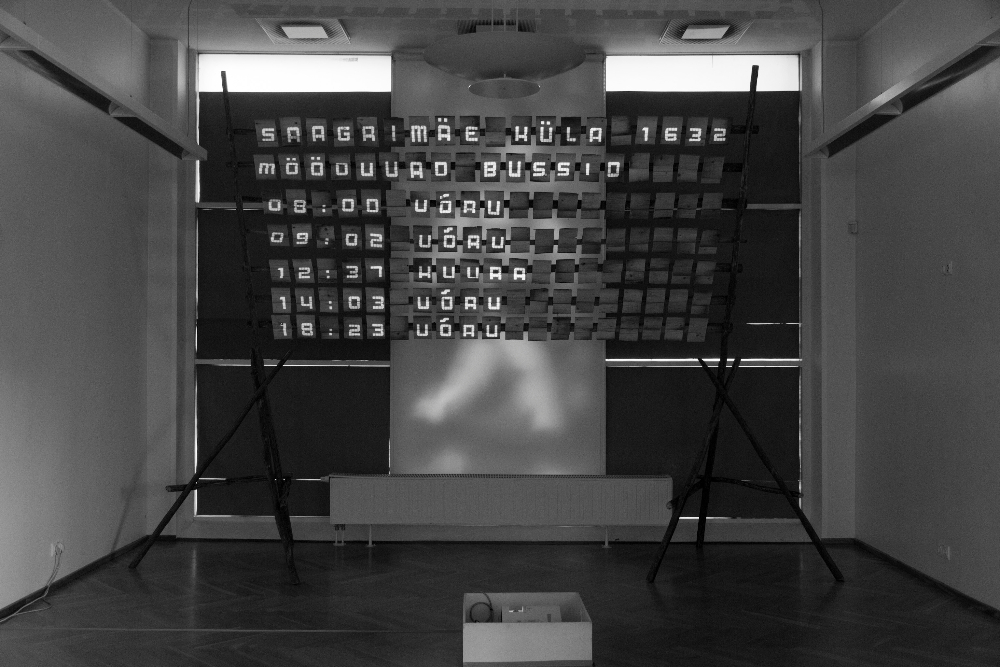
Timo Toots, Laastuekraan (Shingle Board), mixed media interactive installation, 2014. Photograph by Timo Toots
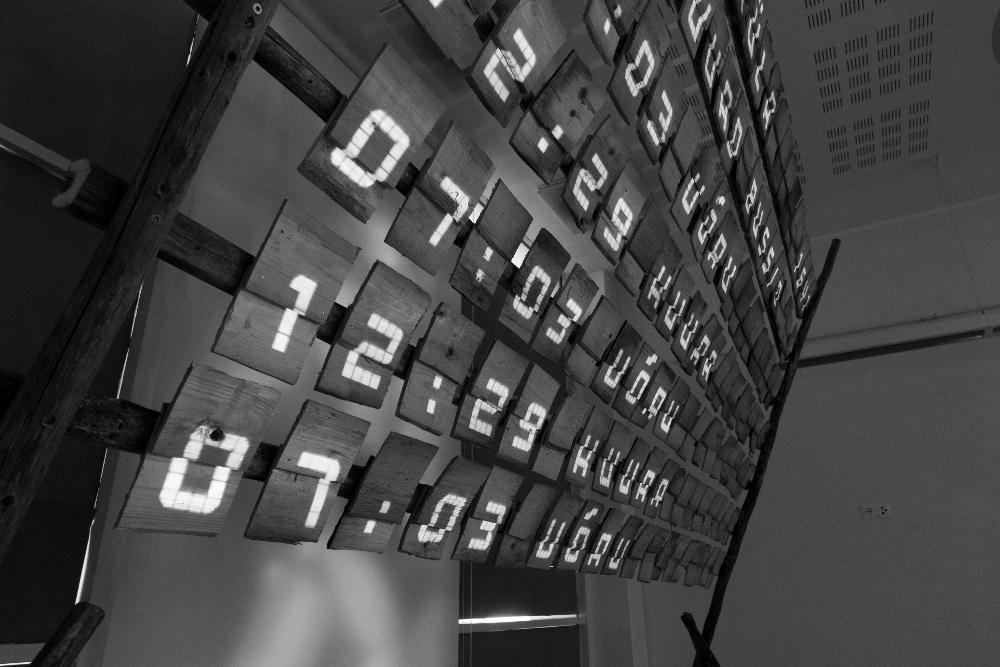
Timo Toots, Laastuekraan (Shingle Board), mixed media interactive installation, 2014. Photograph by Timo Toots
In the gallery, a cast cement cube embedded with a plastic Bluetooth symbol produced by a 3D printer is a place to collect data, in a work titled “Digital Fossil” authored by Suisalu. At the Vorstimägi village there is a rock embedded with a small computer where you may dump unwanted data via your Bluetooth device. The data is collected in a computer buried in the cast cement cube connected to a solar panel hanging on the gallery wall.
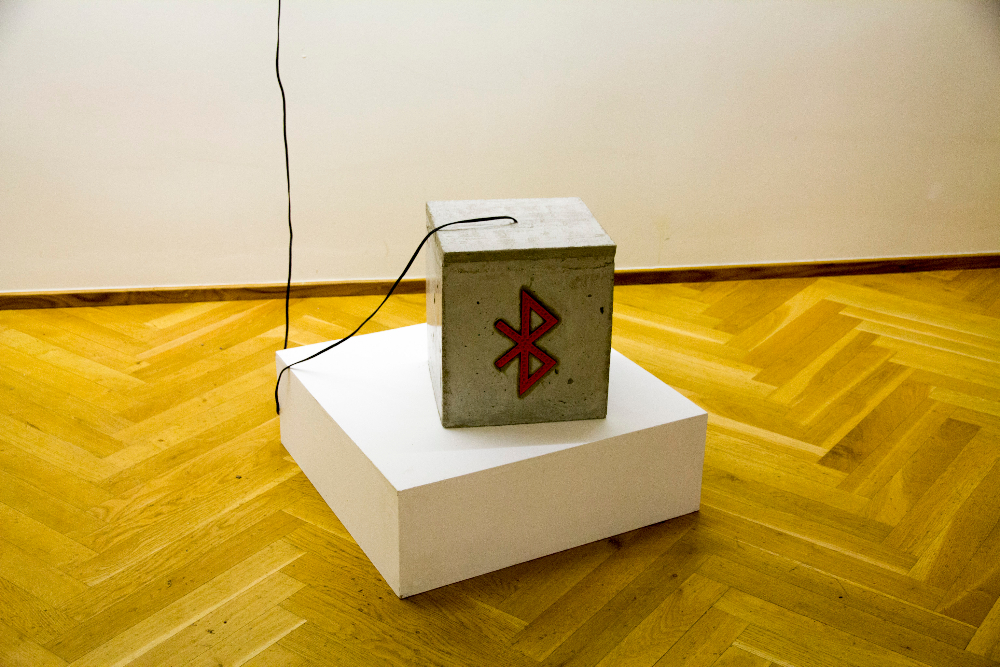
Taavi Suisalu, Digital Fossil, mixed media interactive sculpture, 2014
Evelyn Müürsepp-Grzinich created an installation at the disused house in Kaku, suspended from the ceiling, a grouping of woven grass forms, each nestling a different type of alarm clock, some electric and some mechanical, and in the calm of the country side the overlapping ticking of the clocks composes an eerie soundscape. In the gallery we see photo documentation and a single swinging grass sack; even in the hub of the opening I can hear the ticking of the mechanical clock within.
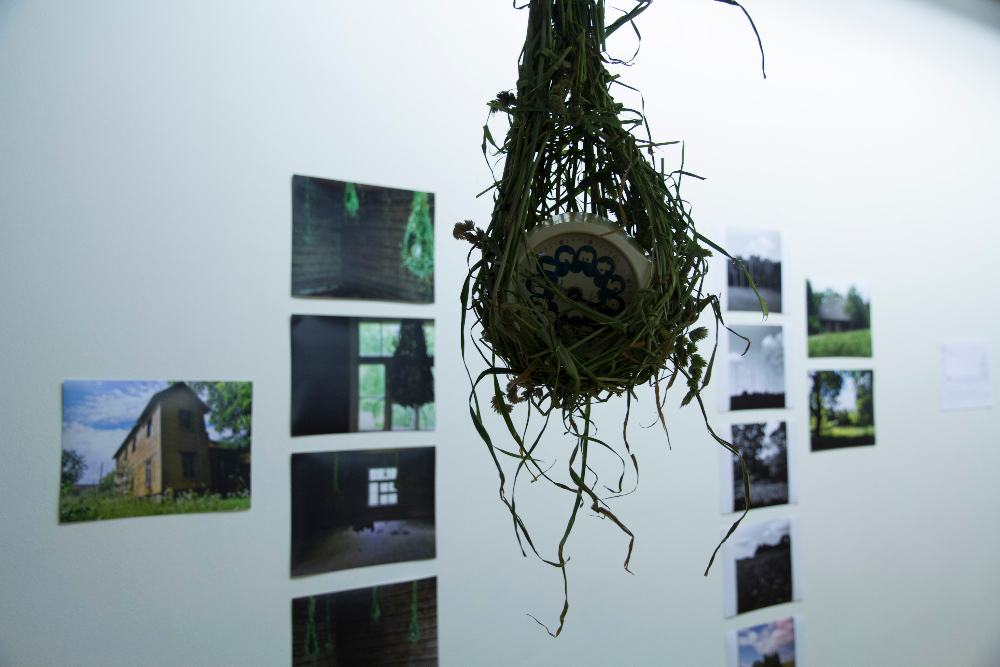
Evelyn Müürsepp-Grzinich, untitled installation, mixed media, 2014
Searching to locate another sound in the gallery I identify two low tech speakers in the southeast corner. A ten liter glass jug of apples collected from Vorstimägi village fermenting with sugar and bread. The regulator which allows gas to escape is connected to a contact microphone and through a rope of intertwined cables the sound is digitized, distorted and amplified in physical space mixing ancient, mechanical and digital technology based on principles of decay titled “Vorstimäe biit” (Beat of Vorstimäe) authored by Erik Alalooga. In the neighboring space and at the same time is exhibition of paintings and ceramics by students in Võrumaa. Between their snacks and our two liter plastic bottle of moonshine, the groups intermingled; while many of us started our art education with painting and ceramics we examine the topic of abandoned villages in a language built on discourse and history. Rather than examining questions like: Why do governments declare places abandoned and how does it tap into sentimental and nostalgic notions of rural life? We search for a common thread between lived experience mediated through technology. On view in Võru gallery are signs and symbols to guide you to the countryside, challenging notions of in use and abandoned.

Erik Alalooga, Vorstimäe biit (Beat of Vorstimäe), mixed media sound installation , 2014
During the week prior to the exhibition, Maajaam realizes contemporary ideals of utopian return to nature; where technology is an integral part of the culture. YouTube tutorials retrace the oral traditions of our ancestors; guiding us in the ways of farm and forest, and teach us how to hack, remix, design and program personalized technology to weave together nature and new media in meaningful ways.
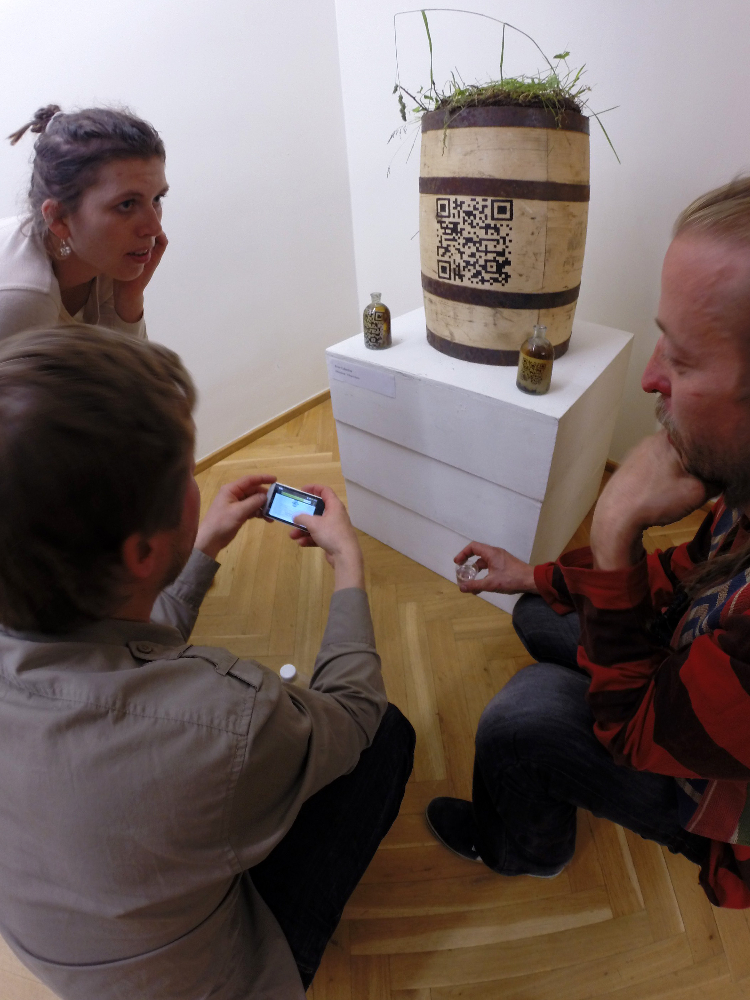
Error Village Estates installation, signs and symbols to lead you to the landscape.
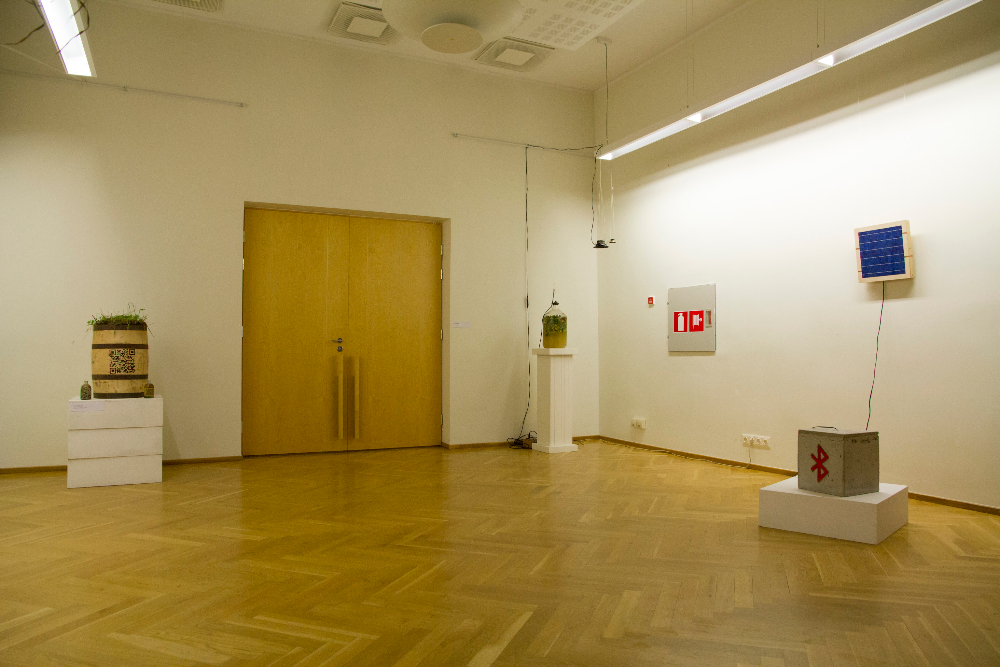
Võru City Gallery, 26 June 2014
The closing event takes place on SATURDAY 26th of July
Preregistration buss@taavisuisalu.com
Bus from Tartu, Vanemuine parking lot 12:00
Bus from the Võru City Gallery 14:00
Visit the installations in the landscape, also sound performances by Derek Holzer and Marco Donnarumma, Patrick McGinley and Villem Jahu.
Artists: Erik Alalooga, Error Collective, John Grzinich, Evelyn Müürsepp-Grzinich, Ott Pilipenko, Taavi Suisalu, Timo Toots
Photographs by Timo Toots and Justin Tyler Tate






























